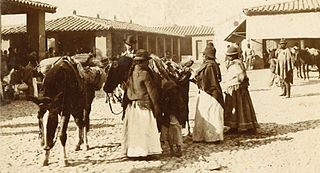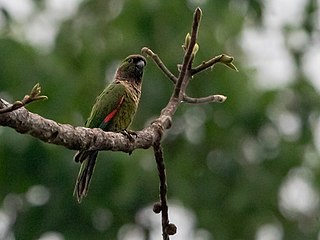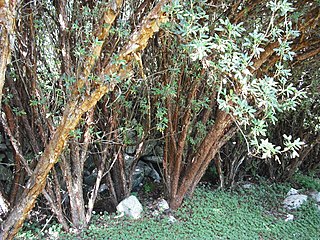Aymara may refer to:
Aymara may refer to:

Quechua, usually called Runasimi in Quechuan languages, is an indigenous language family spoken by the Quechua peoples, primarily living in the Peruvian Andes. Derived from a common ancestral language, it is the most widely spoken pre-Columbian language family of the Americas, with an estimated 8–10 million speakers as of 2004. Approximately 25% of Peruvians speak a Quechuan language.

Rheas, also known as ñandus or South American ostrich, are moderately-sized South American ratites of the order Rheiformes. They are distantly related to the African ostriches and Australia’s emu, with rheas placing just behind the emu in height and overall size.

The Aymara or Aimara people are an indigenous people in the Andes and Altiplano regions of South America; about 2.3 million live in northwest Argentina, Bolivia, Chile, and Peru. Their ancestors lived in the region for many centuries before becoming a subject people of the Inca in the late 15th or early 16th century, and later of the Spanish in the 16th century. With the Spanish American wars of independence (1810–1825), the Aymaras became subjects of the new nations of Bolivia and Peru. After the War of the Pacific (1879–1883), Chile annexed territory with Aymara population.

Andean music is a group of styles of music from the Andes region in South America.

Aymara is an Aymaran language spoken by the Aymara people of the Bolivian Andes. It is one of only a handful of Native American languages with over one million speakers. Aymara, along with Spanish and Quechua, is an official language in Bolivia and Peru. It is also spoken, to a much lesser extent, by some communities in northern Chile, where it is a recognized minority language.

Aymaran is one of the two dominant language families in the central Andes alongside Quechuan. The family consists of Aymara, widely spoken in Bolivia, and the endangered Jaqaru and Kawki languages of Peru.

Quechua people or Quichua people may refer to any of the indigenous peoples of South America who speak the Quechua languages, which originated among the Indigenous people of Peru. Although most Quechua speakers are native to Peru, there are some significant populations in Ecuador, Bolivia, Chile, Colombia, and Argentina.
Tecnocumbia is a style of Cumbia where there is a fusion between electronic sounds generated by electronic musical instruments through electronic drums, the electric guitar, synthesisers, and samplers. "Tecnocumbia" was a word developed in Mexico to describe this type of music. However, the style of music was developed throughout South America with different names given to it before the name "Tecnocumbia" was adopted as the single denomination for the music.

Spanish is the de facto official and administrative language of Chile. It is spoken by 99.3% of the population in the form of Chilean Spanish, as well as Andean Spanish and Chilean Catalan. Spanish in Chile is also referred to as "castellano". Although an officially recognized Hispanic language does not exist at the governmental level, the Constitution itself, as well as all official documents, are written in this language.

The white-eyed parakeet, known in aviculture as white-eyed conure, is a species of bird in subfamily Arinae of the family Psittacidae, the African and New World parrots. It is found in every mainland South American country except Chile and also on Trinidad.

The black-capped parakeet, also known as the black-capped conure or rock conure in aviculture, is a parrot native to the south-western Amazon Basin and adjacent east Andean slopes in Peru, Bolivia and Brazil. It has a total length of approximately 25 cm. It is mostly green with off white scalloping on the hindneck and breast and red primary coverts.

The peach-fronted parakeet, known as the peach-fronted conure in aviculture, is a species of bird in subfamily Arinae of the family Psittacidae, the African and New World parrots. It is found in Argentina, Bolivia, Brazil, Paraguay, Peru, and Suriname.

The mitred parakeet, also known as the mitred conure in aviculture, is a species of bird in subfamily Arinae of the family Psittacidae, the African and New World parrots. It is native to Argentina, Bolivia, and Peru. It has been introduced to Uruguay and is established there. There are also substantial populations in the US states of California and Florida and smaller numbers in Hawaii.

The tui parakeet is a species of bird in subfamily Arinae of the family Psittacidae, the African and New World parrots. It is found in Bolivia, Brazil, Colombia, Peru, and possibly Ecuador.

The mountain parakeet, also known as the golden-fronted parakeet, is a species of parrot, one of two in the genus Psilopsiagon within the family Psittacidae. It is found in the Puna grassland. Its natural habitat is subtropical or tropical high-altitude shrubland. Four subspecies are recognised.

The grey-hooded parakeet, also known as the Aymara parakeet or Sierra parakeet, is a species of parrot in the family Psittacidae. It is found in northwestern Argentina and Bolivia. Its natural habitat is subtropical or tropical high-altitude shrubland.

The golden-spotted ground dove is a species of bird in the family Columbidae. It is found in Argentina, Bolivia, Chile, and Peru.

The Chilean swallow is a species of bird in the family Hirundinidae. It breeds in Chile and Patagonia, migrating north as far as Bolivia, Paraguay, and Rio Grande do Sul.

Polylepis racemosa is a species of small tree in the family Rosaceae. It is endemic to Peru, Bolivia, and Ecuador. It is threatened by habitat destruction. The International Union for Conservation of Nature has assessed the conservation status of this tree as "vulnerable".
P. intermedia may refer to: